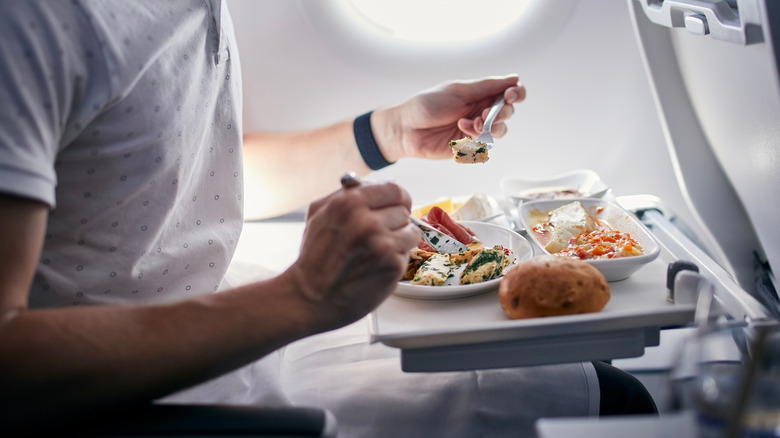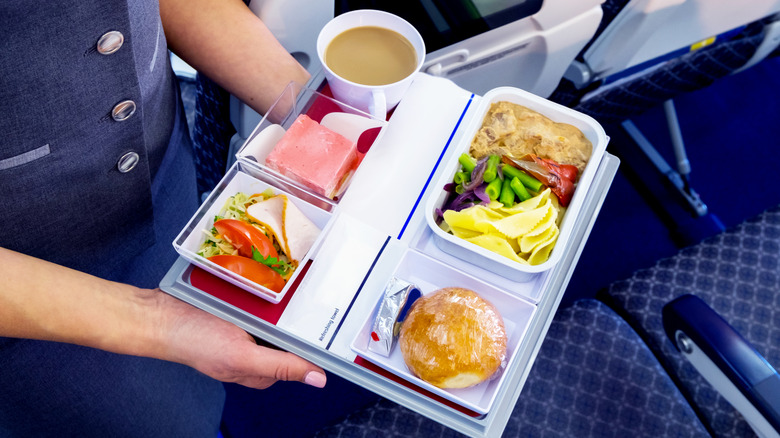Why Gordon Ramsay Refuses To Eat On Planes
Unless you're flying first class with five-course meals, tins of caviar, and the finest bubblies to sip on during take-off, airplane food isn't something most people get excited about. Granted, Chrissy Teigen may very much disagree — she did confess on X, formerly Twitter that airplane food "fascinates" her and that she has "never turned it down (no matter where I am seated!)."
But there are plenty who can't quite relate to Teigen's enthusiasm for airplane food, including Gordon Ramsay — who isn't known to hold back on his sharp opinions. "There's no f***ing way I eat on planes," Ramsay firmly told Refinery29 during an interview, leaving no doubts about where he stood on the to-eat-or-not-eat airplane food conundrum.
Ramsay's rather steadfast take isn't so much about the taste, texture, or flavor of airplane food. Instead, it's because he knows exactly "where this [airplane] food's been and where it goes, and how long it took before it got on board." This is because the "Kitchen Nightmares" host isn't new to the world of airplane food. In fact, he knows it inside out thanks to his decade-long work with Singapore Airlines, which involved designing their flight menus. Besides, Ramsay isn't the only chef with a not-so-favorable take on airplane food. Anthony Bourdain, too, was known to refrain from eating in the sky, claiming that "no one has ever felt better after eating plane food" (via Bon Appétit).
What makes flight food questionable?
Ramsay's insinuation that his dislike for flight food comes from the knowledge of all that goes on behind the scenes makes one wonder: What is it about where airplane food comes from that's concerning? For one, while flight menus are designed by an airline's in-house team of experts, the actual cooking happens on-ground by third-party caterers whose kitchens are usually located not too far from an airport. This makes it possible for food to be cooked fresh on the day of a flight — no more than a few hours before it is meant to be heated, served, and eaten. The problem, however, comes from the potentially questionable hygiene standards of these facilities.
NBC News analyzed past inspections conducted by the FDA only to find an abundance of reports on sanitation, hygiene, and contamination-related transgressions at catering facilities. These included 501 cases since October 2008 that violated sanitation and contamination guidelines such as improper temperature handling and cross-contamination between raw and cooked meat. There were 36 more instances where rodents, vermin, and flies were found inside kitchens.
Bird and rodent droppings were also found all over some kitchens along with foods that were marred with dust, condensation, and mold, or which were outright expired. There have also been cases where catering facilities have tested positive for the presence of Listeria in their kitchens, which may perhaps explain why those in the know wouldn't want to touch airplane food with a ten-foot pole.
Lack of proper regulation is a contributing factor
The transgressions found at airline catering facilities are not very different from the concerns that also plague restaurants and food manufacturing facilities, but what makes flight food, in particular, dodgy is the lax regulations. While restaurants should be inspected once in six months per FDA guidelines – as reported by NBC News, airline catering facilities can go anywhere between three to five years without any checks. As for the airlines themselves, there are very few guidelines as to when and how frequently they should be inspected. Even when inspections are undertaken and violations are found, there are seldom any penalties applied to either the caterer or the airline.
This isn't to say that all catering facilities and airlines have questionable safety standards, but there have been plenty of cases to justify why someone, including Ramsay, wouldn't want to take that risk. Needles have been found among sandwiches, shards of glass inside ice creams, mold lacing snack boxes, and even worms wriggling their way out of cold food. For Ramsay, eating in a restaurant at the airport is a much safer bet in comparison — preferably at his own establishment Plane Food at London Heathrow's terminal five, but if that's not an option, any Italian bar with fine red wine, fruits, meats, and cheese will do he says!



